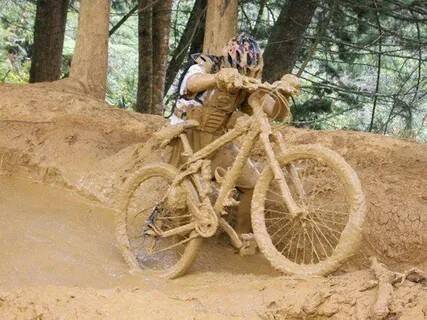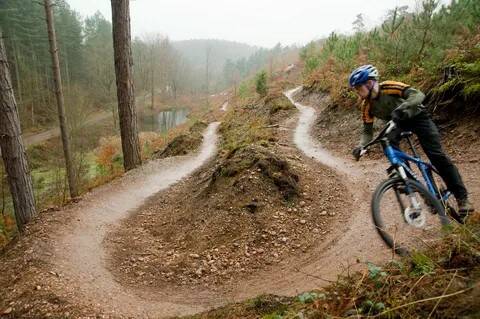
A dirt bike pit is a designated area where riders can work on and maintain their dirt bikes. It’s typically an outdoor space, often located near a track or trail, where riders can perform basic repairs, maintenance, and modifications on their bikes.
An adult dirt bike pit is specifically designed for adult riders who own and operate dirt bikes. It’s a place where riders can come together to work on their bikes, share knowledge and expertise, and socialize with other riders.
In an adult dirt bike pit, riders may have access to tools, equipment, and supplies needed for basic repairs and maintenance. These may include wrenches, sockets, pliers, tire irons, and other common tools. Some pits may also have a designated area for cleaning and washing bikes.
It’s important to note that dirt bike riding can be dangerous, and riders should always wear appropriate safety gear, including a helmet, goggles, gloves, and boots. Additionally, riders should always follow local laws and regulations related to dirt bike riding, including requirements for licensing and vehicle registration.
Contents
Types of pits for riding a dirt bike
There are several types of pits that riders can use when riding a dirt bike. Here are some common types:
- Practice pits: These are designated areas where riders can practice and improve their riding skills. Practice pits may be equipped with jumps, turns, and other obstacles designed to simulate real-world riding conditions.
- Race pits: These are designated areas where riders can prepare for dirt bike races. Race pits may be equipped with tools, equipment, and supplies needed for last-minute repairs and adjustments before a race.
- Training pits: These are areas where riders can receive instruction and training from experienced coaches and instructors. Training pits may be equipped with specialized equipment, such as video analysis tools, to help riders improve their technique.
- Freestyle pits: These are designated areas where riders can practice and perform tricks and stunts on their dirt bikes. Freestyle pits may be equipped with ramps, jumps, and other obstacles designed to allow riders to perform aerial maneuvers.
- Maintenance pits: These are designated areas where riders can work on and maintain their dirt bikes. Maintenance pits may be equipped with tools, equipment, and supplies needed for basic repairs and maintenance.
When choosing a pit for riding a dirt bike, it’s important to consider your specific needs and goals. Some pits may be more suitable for beginners, while others may be designed for more experienced riders. It’s also important to ensure that the pit is safe and properly maintained to prevent accidents and injuries.

Practice pits:
Practice pits are designated areas for riders to practice their dirt bike riding skills. They are often located near dirt bike tracks or trails and may be open to riders of all skill levels.
Practice pits may be equipped with various obstacles, such as jumps, berms, and whoops, designed to simulate different riding conditions. The size and difficulty of the obstacles can vary depending on the level of the rider, with easier obstacles for beginners and more challenging ones for advanced riders.
In a practice pit, riders can work on improving their cornering, jumping, and overall riding technique. Riders can also use the pit to test and fine-tune their bike setup, such as suspension and tire pressure.
It’s important to note that practice pits may have rules and regulations that riders must follow, such as a maximum number of riders on the track or designated hours https://www.buydo.eu for riding. Riders should also wear proper safety gear and ride within their skill level to avoid accidents and injuries.
Overall, practice pits are a great way for riders to improve their skills and enjoy riding in a safe and controlled environment.
Race pits:
Race pits are designated areas for riders to prepare for dirt bike races. These pits are often located at the track or trail where the race will take place, and provide riders with a space to make last-minute adjustments to their bike and gear before the race.
In a race pit, riders can set up their bikes and gear, as well as access tools, equipment, and supplies needed for repairs or adjustments. They can also receive assistance from mechanics or other support staff to ensure their bike is in top condition for the race.
Race pits can also serve as a gathering place for riders to socialize and share tips and strategies before the race. It can be a great opportunity to connect with other riders and learn from their experiences.
It’s important to note that race pits may have specific rules and regulations that riders must follow, such as designated hours for access or limitations on the number of mechanics allowed in the pit. Riders should also wear proper safety gear and be aware of their surroundings to avoid accidents and injuries.
Overall, race pits are a crucial component of dirt bike racing and provide riders with the support they need to perform their best on race day.
Training pits:
Training pits are designated areas for riders to train and practice their dirt bike riding skills. These pits are often private or semi-private areas, sometimes owned by professional riders or trainers, and may be equipped with various obstacles and terrain features to simulate different riding conditions.
In a training pit, riders can work on improving their riding technique and conditioning, such as mastering jumps, improving speed and agility, or developing endurance. They can also use the pit to test and fine-tune their bike setup, such as suspension and tire pressure, to optimize their performance.
Training pits may also offer coaching or instruction from professional riders or trainers, who can provide feedback and guidance to help riders improve their skills and technique. Riders can also use the pit to practice specific aspects of racing, such as starts or passing.
It’s important to note that training pits may have rules and regulations that riders must follow, such as a maximum number of riders on the track or designated hours for training. Riders should also wear proper safety gear and ride within their skill level to avoid accidents and injuries.
Overall, training pits can be a great way for riders to improve their skills and fitness in a controlled and supportive environment.
Freestyle pits:
Freestyle pits are designated areas for riders to practice and perform freestyle motocross (FMX) tricks and stunts on their dirt bikes. These pits are typically private or semi-private areas, sometimes owned by professional freestyle riders or trainers, and may be equipped with various ramps, jumps, and obstacles to facilitate FMX-style riding.
In a freestyle pit, riders can work on perfecting their tricks and stunts in a controlled environment, without the distractions or hazards of a public riding area. They can also experiment with new tricks and combinations, and push the limits of their riding abilities.
Freestyle pits may also offer coaching or instruction from professional freestyle riders or trainers, who can provide guidance on technique, safety, and performance. Riders can also use the pit to rehearse and prepare for FMX competitions or shows.
It’s important to note that freestyle pits can be dangerous, and riders should always wear proper safety gear and ride within their skill level to avoid accidents and injuries. Professional freestyle riders often have years of training and experience before attempting complex FMX tricks, and even then, they often rely on rigorous safety protocols and equipment to minimize risk.
Overall, freestyle pits can be an exciting and rewarding way for riders to push their limits and develop their freestyle motocross skills in a safe and controlled environment.
Maintenance pits:
Maintenance pits are designated areas for riders to perform routine maintenance and repairs on their dirt bikes. These pits are typically located in a garage or workshop, and may be equipped with various tools, equipment, and supplies needed for bike maintenance.
In a maintenance pit, riders can perform tasks such as changing oil, replacing tires, adjusting brakes and suspension, and cleaning and lubricating various components of the bike. They can also diagnose and troubleshoot issues, and perform more extensive repairs or modifications as needed.
Maintenance pits may also offer resources or guidance on bike maintenance, such as instructional videos or workshops on specific tasks or techniques. Riders can also use the pit to learn more about the mechanics and performance of their bike, and develop the skills and knowledge needed to perform basic maintenance tasks themselves.
It’s important to note that maintenance pits may require certain safety precautions and equipment, such as eye protection, gloves, and proper ventilation, to avoid injuries or exposure to harmful chemicals. Riders should also follow manufacturer guidelines and recommended practices when performing maintenance tasks, and seek professional help for more complex repairs or modifications.
Overall, maintenance pits can be a valuable resource for riders to keep their dirt bikes in top condition, and develop the skills and knowledge needed to maintain and repair their bike themselves.